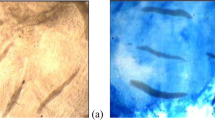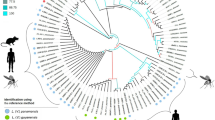Abstract
Four hyper-variable regions (HVR-I to -IV) found in 18S ribosomal DNA sequences were compared among 34 isolates of 15 species of the genus Strongyloides to evaluate their diagnostic value. HVR-I to -III were short, and plural species exhibit the same nucleotide arrangement. Meanwhile, HVR-IV had 23 to 39 nucleotides, showing species-specific arrangements, except Strongyloides ransomi and Strongyloides venezuelensis, which had the same nucleotide sequence in HVR-IV but were readily distinguished by the difference in HVR-I and -III. Isolates of Strongyloides stercoralis from humans of USA, Japan, and Philippines, chimpanzees, and dogs had an identical sequence in this region. Meanwhile, intraspecific polymorphism in HVR-IV nucleotide arrangement was observed among isolates of Strongyloides fuelleborni and Strongyloides callosciureus, presumably reflecting process of geographical dispersal and adaptation to the hosts.



Similar content being viewed by others
References
Arakaki T, Hasegawa H, Asato R, Ikeshiro T, Kinjo F, Saito A, Iwanaga M (1988) A new method to detect Strongyloides stercoralis from human stool. Jpn J Trop Med Hyg 16:11–17
Arakaki T, Iwanaga M, Kinjo F, Saito A, Asato R, Ikeshiro T (1990) Efficacy of agar-plate culture in detection of Strongyloides stercoralis infection. J Parasitol 76:425–428
Blaxter ML, De Ley P, Garey JR, Liu LX, Scheldeman P, Vierstraete A, Vanfleteren JR, Mackey LY, Dorris M, Frisse LM, Vida JT, Thomas WK (1998) A molecular evolutionary framework for the phylum Nematoda. Nature 392(6671):71–75
Blouin MS (2002) Molecular prospecting for cryptic species of nematodes: mitochondrial DNA versus internal transcribed spacer. Int J Parasitol 32:527–531
Cannone JJ, Subramanian S, Schnare MN, Collett JR, D’Souza LM, Du Y, Feng B, Lin N, Madabushi LV, Müller K, Pande N, Shang Z, Yu N, Gutell RR (2002) The comparative RNA web (CRW) site: an online database of comparative sequence and structure information for ribosomal, intron, and other RNAs. BMC Bioinformatics 3:2 (available on: www.biomedcentral.com/1471-2105/3/2)
Dorris M, Viney ME, Blaxter ML (2002) Molecular phylogenetic analysis of the genus Strongyloides and related nematodes. Int J Parasitol 32:1507–1517
Floyd RM, Rogers AD, Lambshead PJD, Smith CR (2005) Nematode-specific PCR primers for the 18S small subunit rRNA gene. Mol Ecol Notes 5:611–612
Glove DI (1989) Diagnosis. In: Grove DI (ed) Strongyloidiasis: a major roundworm infection of man. Taylor & Francis, London, pp 175–197
Hira PR, Patel BG (1977) Strongyloides fülleborni infections in man in Zambia. Am J Trop Med Publ Hlth 26:640–643
Hu M, Chilton BN, Grasser RB (2003) The mitochondrial genome of Strongyloides stercoralis (Nematoda)—idiosyncratic gene order and evolutionary implications. Int J Parasitol 33:1393–1408
Katayama T, Yamamoto M, Wada H, Satoh N (1993) Phylogenetic position of acoel turbellarians inferred from partial 18S rDNA sequences. Zool Sci 10:529–536
Kelly A, Little MD, Voge M (1976) Strongyloides fülleborni-like infections in man in Papua New Guinea. Am J Trop Med Publ Hlth 25:694–699
Linstow OV (1905) Strongyloides fülleborni n. sp. Centr Bakteriol Parasitol I Abt Orig 38:532–534
Nakao M, Sako Y, Ito A (2003) Isolation of polymorphic microsatellite loci from the tapeworm Echinococus multilocularis. Inf Gen Evol 3:159–163
Nobusue K, Miyagi K, Morimoto K, Watanabe K, Hasegawa H, Sato H, Ariyoshi K (2007) A case of mixed infection with Necator americanus and zoonotic Strongyloides sp. acquired in Tanzania. Trop Med Hlth 36(suppl):36
Pampiglione S, Ricciardi ML (1971) The presence of Strongyloides fülleborni von Linstow, 1905 in man in Central and East Africa. Parassitologica 13:257–268
Putland RA, Thomas SM, Grove DI, Johnson AM (1993) Analysis of the 18S ribosomal RNA gene of Strongyloides stercoralis. Int J Parasitol 23:149–151
Sato H, Suzuki K, Osanai A, Kamiya H, Furuoka H (2006) Identification and characterization of the threadworm, Strongyloides procyonis, from feral raccoons (Procyon lotor) in Japan. J Parasitol 92:63–68
Sato H, Torii H, Une Y, Ooi H-K (2007) A new rhabditoid nematode species in Asian sciurids, distinct from Strongyloides robustus in North American sciurids. J Parasitol 93:1476–1486
Speare R (1989) Identification of species of Strongyloides. In: Grove DI (ed) Strongyloidiasis: a major roundworm infection of man. Taylor & Francis, London, pp 11–83
Thompson JD, Higgins DG, Gibson TJ (1994) CLUSTRAL W: Improving the sensitivity of progressive multiple sequence alignment through sequence weighting, positions-specific gap penalties and weight matrix choice. Nucleic Acids Res 22:4673–4680
Viney ME, Ashford RW, Barnish G (1991) A taxonomic study of Strongyloides Grassi, 1897 (Nematoda) with special reference to Strongyloides fuelleborni von Linstow, 1905 in man in Papua New Guinea and the description of a new subspecies. Syst Parasitol 18:95–109
Acknowledgments
Sincere thanks are rendered to G. Ogura (University of Ryukyus), Y. Nawa, Y. Horii (Miyazaki University), F. Nakamura (Bokuto Hospital), M. Nishimura (Okinawa Prefecture Institute of Public Health), E. Kimura (Aichi Medical University), M. Asakawa (Rakuno Gauken University), K. Imai (Naruto Veterinary Clinic), H. Kino (Hamamatsu Medical University), T. Udono (Sanwa Kagaku Co. Ltd.), K. Miyagi, K. Nobusue (Nagasaki University), and S. Fujita (Yamaguchi University) for their kindness in supplying Strongyloides nematodes. Thanks are also expressed to M. Nakao (Asahikawa Medical University) and K. Ando (Mie University) for their kind technical information on DNA extraction and PCR. This study was financially supported by grants-in-aid from the Japan Society for Promotion of Sciences, nos. 19580355 and 20570090, and Morinaga Service Foundation, Tokyo, Japan (2008).
Author information
Authors and Affiliations
Corresponding author
Rights and permissions
About this article
Cite this article
Hasegawa, H., Hayashida, S., Ikeda, Y. et al. Hyper-variable regions in 18S rDNA of Strongyloides spp. as markers for species-specific diagnosis. Parasitol Res 104, 869–874 (2009). https://doi.org/10.1007/s00436-008-1269-9
Received:
Accepted:
Published:
Issue Date:
DOI: https://doi.org/10.1007/s00436-008-1269-9




